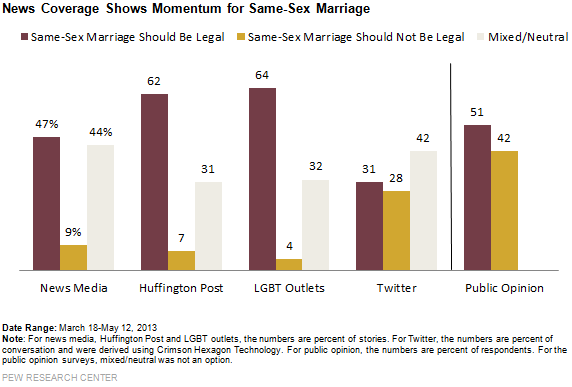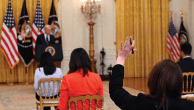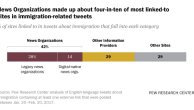In a period marked by Supreme Court deliberations on the subject, the news media coverage provided a strong sense of momentum towards legalizing same-sex marriage, according to a new study by the Pew Research Center. Stories with more statements supporting same-sex marriage outweighed those with more statements opposing it by a margin of roughly 5-to-1.
In the coverage studied, the central argument among proponents of same-sex marriage was one of civil rights. Arguments against were more varied, but most often voiced the idea that same-sex marriage would hurt society and the institution of traditional marriage.
Almost half (47%) of the nearly 500 stories studied from March 18 (a week prior to the Supreme Court hearings), through May 12, primarily focused on support for the measure, while 9% largely focused on opposition and 44% had a roughly equal mix of both viewpoints or were neutral. In order for a story to be classified as supporting or opposing same sex marriage, statements expressing that position had to outnumber the opposite view by at least 2-to-1. Stories that did not meet that threshold were defined as neutral or mixed.
[1]
This news media focus on support held true whether the stories were reported news articles or opinion pieces, and was also the case across nearly all media sectors studied. All three of the major cable networks, for instance, had more stories with significantly more supportive statements than opposing, including Fox News.
In addition to the main set of news media, this study also examined same-sex marriage coverage in three other media segments: Twitter, the Huffington Post – which has a dedicated microsite to “Gay Voices” and produced so much coverage that it was examined separately from the rest of the news media – and a mix of LGBT news outlets.
Twitter postings on the subject were nearly evenly split between support and opposition for the measure, aligning much more closely with public opinion than with the news media. Coverage on the Huffington Post, on the other hand, was even more tilted towards support of same-sex marriage than the rest of the news media. Indeed, 62% of the 365 stories on the site were dominated with statements of support – very close to the level of support in the LGBT news outlets studied.

Within the media debate on the subject, this report found that those arguing for same-sex marriage had a more consistent message than those arguing against.
Among supporters of same-sex marriage, the main argument was framed around civil rights. Nearly half (49%) of the stories studied in the news media included the argument that same-sex couples should be allowed to marry because it is an issue of equality. This was also the most common argument to appear in the LGBT media as well as on HuffingtonPost.com.
The arguments against tended to vary more. The most common opposing argument was the idea that same-sex marriage would hurt society and harm traditional marriage, though less than a fifth of stories (18%) included this claim. Other arguments against the measure included the idea that homosexuality is immoral and that the government should not impose a new definition of marriage that strays from the traditional notion of one man and one woman.
These are among the key findings from a new study of more than 1,080 stories and more than 2.4 million tweets by the Pew Research Center on how the media has covered the issue of same-sex marriage from March 18, 2013 – a week before the Supreme Court hearings, through May 12. The main news sample includes a mix of six websites from Politico to Buzzfeed to Gawker, 11 newspapers, news programs from the three main network news outlets along with PBS, and a mix of programs on the three cable television channels, talk radio, NPR and syndicated radio headlines. Researchers also examined and separately analyzed coverage on the Huffington Post, coverage across a mix of leading LGBT news publications and the tone of the discussion on Twitter. Except for LGBT publications and Twitter, outlets were captured on a rotating basis. For newspapers, the LexisNexis database does not include wire copy or syndicated columns, but coding of a random sample of wire stories during this period produced findings very similar to the newspaper numbers overall. (See the full methodology for details.)
Among other findings in the study:
- Most of the attention to the subject came in the five days surrounding the Supreme Court hearings (March 25 – 29). Of the main news media stories studied, 55% were produced in that period. The same was true for 44% of the stories on the Huffington Post and nearly half (47%) of the conversation on Twitter. The LGBT outlets, on the other hand, were somewhat more consistent in the amount of attention devoted to the subject throughout the eight weeks studied.
- In addition to the main arguments for and against the issue, the notion that the Supreme Court should not have taken up gay marriage was a common theme. About one-in-six (17%) of the stories in the main news media studied included this claim. In most instances, this case was made by legal scholars and the Supreme Court justices themselves as they wrestled with the legal questions. On a few occasions, however, the argument was used by opponents of same-sex marriage.
- Despite the preponderance of supportive coverage across media sectors, the level of mixed or neutral coverage varied among individual outlets. In cable news, for example, MSNBC produced 30% mixed, 64% supporting and 6% opposing, among the stories studied. The coverage on Fox News was 63% mixed, 29% supportive of the measure and 8% opposing. And on CNN, the break was 57% mixed, 39% supporting and 4% in opposition. In newspapers, the Wall Street Journal and USA Today stood out for higher levels of mixed or neutral reporting, 70% and 67%, respectively, and more even ratio of supporting versus opposing stories.
-
While expressing strong support for the measure, LGBT news outlets focused on a different element of the story than any of the other media studied. A full quarter, 25%, of the coverage in the 11 LGBT outlets studied focused on local and state laws, an element that made up just 10% of the other news coverage. Generally, those stories detailed developments in marriage legislation on the state level.
- On social media, the opinions expressed on Twitter were closely split between those that supported (31%) and those that opposed (28%). There were, however, significant shifts in the sentiment over the nine weeks studied. During the week prior to and the week of the Court hearings, more of the Twitter conversation favored same-sex marriage. The two following weeks saw a reverse with more posts in opposition. Then, during the last month of the study, assertions in favor of the measure once again took the lead.
- Journalists and citizens following the subject on the Internet used different terms when discussing the subject. An analysis using Google Trends, a service that tracks the phrases used during Google searches, revealed that citizens searched more often for “gay marriage” than “same-sex marriage.” Journalists, on the other hand, used “same-sex marriage” more frequently – according to searches of the LexisNexis database. The term “marriage equality” was not used by either as much, but did see an increase over time.
The findings show how same-sex marriage supporters have had a clear message and succeeded in getting that message across all sectors of mainstream media. Other elements may have also added to the greater focus on support versus opposition. Many of the newsmaking events in this time period indicated momentum towards same-sex marriage. These included endorsements from politicians, legislation at the state level and shifts in public opinion tracked by surveys. Second, during the week of the hearings, when most of the coverage occurred, the media offered many profiles of the plaintiffs or members of the LGBT community with few voices of opposition mixed in. Finally, commentators who favored same-sex marriage, such as Rachel Maddow and Chris Matthews, spent more time discussing the issue than commentators who opposed it, such as Sean Hannity and Bill O’Reilly.
Footnote
[1]




